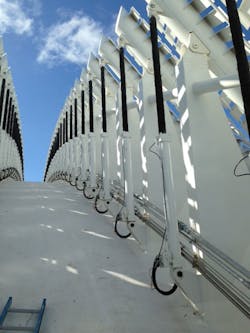Non-Tie-Rod Cylinders Move Louvres on New Florida Building
Engineers and architects in Florida were challenged to complete the Innovation, Science, and Technology (IST) Building at Florida Polytechnic University in Lakeland, Fla. It was designed by Spanish architect Santiago Calatrava Vall and will be the centerpiece for Florida’s newest state institution. It will house classrooms and auditoriums for teaching science, engineering, and math, as well as administrative offices, common areas, and a number of cutting-edge laboratories. The latter include a Supercomputer and Student Data Center, a Visualization and Technology Collaboration Lab, and a Rapid Application Development Makerspace Lab with 3D printing capabilities. The $60 million, two-story building also includes 94 louvered arms that raise and lower to track the sun above a glass roof.
In the past positioning those louvers might’ve been handled by tie-rod cylinders, the devices that typically deliver power to large presses, mills, foundries, power generators, and for oil and gas exploration and other heavy-duty applications. They are powerful, reliable, and can be mounted in a variety of orientations. But they do have issues. Servicing them can be problematic due to the complexities of assembling and torqueing long tie rods. And for some design-sensitive applications, the visible tie-rods are not exactly aesthetic.
In addition to the eliminating tie rods, the 2HB (and 3HB) cylinders feature high-compressive strength and non-metallic piston wear rings that minimize tube scoring. A cartridge-style needle valve with a captive micro-adjust screw ensures accurate cushion tuning. All steel head and cap blocks are precision sized, finished on all sides, and bored and grooved for concentric alignment of mating parts.
Instead, the engineers opted to use 2HB hydraulic cylinders from Parker Hannifin, with each cylinder handling its own louvre. They are available in sizes from 1.5 to 14-in. bore and are dimensionally interchangeable with their tie-rod counterparts because they adhere to the same industry standard [ANSI (NFPA) T3.6.7R3—2009[. Compared to tied rods, however, they are simpler and weigh much less.
2HB cylinders and their close cousins, 3HB cylinders, eliminate tie rods by using flanges threaded onto both ends of the cylinder body. The head and cap bolt to the threaded body flanges with socket head cap screws and only a small gap between. The gap lets the head and cap be preloaded against the end of the cylinder body when the socket head cap screws are torqued.
The resulting assembly presents a cleaner, more aesthetically pleasing design. Perhaps most importantly, 2HBs let users avoid tie-rod-related fatigue and maintenance. The-rod cylinders meet NFPA fatigue tests for reliable performance using standard, field-proven components. They are built to a design safety factor of 4:1 on burst.
An array of rod cylinders in five different sizes keep the louvres at the right angle to either provide shade or artistic motion.
The cylinders also eliminate twisting, stretching, and fatigue concerns, even when compared to the welded flange cylinders favored in challenging long-stroke applications. And unlike welded flange cylinders, which typically are custom orders, 2HB cylinders are made up of standard parts and are readily available.
When cylinder repair is required for a non-tie rod cylinder, a technician only needs to remove four bolts to service the head end, eliminating the need to disassemble any tie rods. The bolted Tri-Lip gland also removes easily for servicing. Shorter downtime means higher throughput, directly benefiting any industry dependent on long-stroke cylinder operations.
In addition to the elimination of tie rods, the 2HB and 3HB cylinders incorporate Parker’s standard, premium-quality design features. High-compressive strength, non-metallic piston wear rings minimize tube scoring. A cartridge-style needle valve with a captive micro-adjust screw ensures accurate cushion tuning. All steel head and cap blocks are precision-sized, finished on all sides, and bored and grooved for concentric alignment of mating parts. 2HB and 3HB cylinders can be equipped with all standard Parker mounting styles or with customized mounts for unusual application requirements.
For the building, each cylinder was assembled with cartridge valves on a manifold, which was bolted to the cap and plumbed to the head end of the cylinder. Further, a spherical rod eye was installed at the rod end and the entire cylinder was painted to match the remainder of the structure.
The cylinders act independently from one another and can manipulate the louvers to provide shade and artistic motion. The louvers are designed to eventually carry photovoltaic tape to generate power for the campus. Each louver arm can move from 65 deg. above the horizontal plane to 48 deg. below that plane. Travelling the full 113 deg. takes about 10 min.



